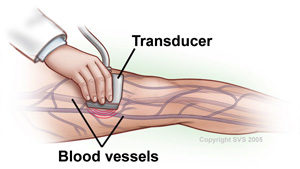What is Deep Vein Thrombosis?
Deep Vein Thrombosis, or DVT, occurs when your blood thickens into a solid clump, forming a clot. Nearly 300,000 first-time cases of DVT occur in the U.S. every year, usually in the leg. This clot can travel to your lungs, making it difficult to breathe, or even cause death. DVT is most commonly treated with a course of blood thinners and follow up with a specialist is recommended before discontinuing use of blood thinners.
What are the symptoms of Deep Vein Thrombosis?
Typically you will notice swelling, pain, redness or warmth along the vein that has the clot. However, DVT can occur without any warning signs.
What causes a DVT?
A DVT forms when you blood flow becomes very slow. This can occur for a variety of reasons but some typical reasons include:
- Inactivity, such as after a major operation or during a flight or long car ride
- Damage to a vein, such as from a traumatic injury
- Cancer and certain other disease and genetic conditions, called hypercoaguable states, that cause you blood to clot more easily
- Medication, especially hormones
How is a DVT diagnosed?
 If you notice pain or swelling in your leg, seek immediate medical attention. Based on your symptoms and physical exam, certain tests may be recommended. An ultrasound is the typical test ordered to diagnosis a DVT.
If you notice pain or swelling in your leg, seek immediate medical attention. Based on your symptoms and physical exam, certain tests may be recommended. An ultrasound is the typical test ordered to diagnosis a DVT.
How is DVT treated?
DVT is usually treated with medication. Blood thinners, also known as anticoagulants, are the most common medicines used to treat DVT. They prevent the blood clot from getting larger by decreasing your blood’s ability to clot. Over time, your body works with the blood thinners to decrease the size and consistency of the clot. Blood thinners can increase your risk of bleeding, so careful follow-up with your physician is recommended.
In some cases, thrombolytic therapy is used to quickly dissolve a blood clot, especially if the clot is large and causing severe symptoms. This treatment has a much higher risk of bleeding than blood thinners, so it is not used unless truly necessary.
Some patients require an IVC Filter to be placed within the inferior vena cava, one of the largest veins in the body. The filter does not stop a blood clot from forming, but can prevent a large clot from entering your lungs.
How can I prevent a DVT?
Maintaining good health can decrease your risk of DVT. Staying physically active, especially following surgery and during long trips is important. If you have cancer or an infection, seek treatment quickly to prevent complications from occurring. If you have a blood clot now or have had one in the past, it is important to discuss this with your physician. Those with a history of DVT are more at risk for developing future DVT’s and other complications.

